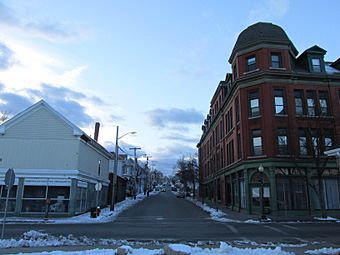Acushnet Heights Historic District facts for kids
Quick facts for kids |
|
|
Acushnet Heights Historic District
|
|

Linden Street
|
|
| Location | Roughly bounded by Summer, Weld, Purchase, Pope, County, and Robeson, New Bedford, Massachusetts |
|---|---|
| Area | 20 acres (8.1 ha) |
| Architect | Multiple |
| Architectural style | Mid 19th Century Revival, Colonial Revival, Late Victorian |
| NRHP reference No. | 89002035 |
| Added to NRHP | December 1, 1989 |
The Acushnet Heights Historic District is a special part of New Bedford, Massachusetts. It's a neighborhood with many old homes and buildings. This area is about 20 acres (8.1 ha) big. It was built starting in the 1860s for workers in the city's factories. This district was added to the National Register of Historic Places in 1989. This means it's an important historical place in the United States.
Contents
Exploring Acushnet Heights
This historic neighborhood is in the middle of New Bedford. It's bordered by Purchase Street on the east and Linden Street on the north. County Street is mostly its western edge, and Pope Street and Clasky Common Park are to the south.
Clasky Common Park
Clasky Common Park is a large open space in the area. It was first created in 1822. The park was made bigger in 1853 to its current size. It's a great spot for people to relax and play.
Homes and Buildings
Most of the homes in Acushnet Heights are made of wood. They show different building styles from the 1840s to the early 1900s. These styles include Mid 19th Century Revival and Late Victorian. There are also some brick buildings. These are mostly shops on Purchase Street and an old fire station. You can also find four churches from the 1800s in the district.
A Look Back in Time
New Bedford became a town in 1787. By the early 1800s, it was a very busy port for ships. As the city grew, more people moved north from the downtown area.
Growth of the Neighborhood
In the late 1800s, many large factories were built. These factories were near the Acushnet River. They brought many workers to New Bedford. The Acushnet Heights area grew quickly because of this. Factories built homes for their workers. Other people also built houses to rent or sell. By 1870, this area was known as "Acushnet Heights." Many people living here worked at the Wamsutta Mills.



